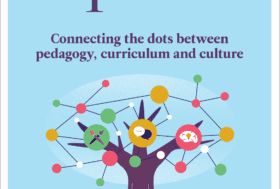Christine Parker, Pen Green Teaching School Alliance, UK
In this video, Christine Parker discusses schema theory in early child development, including:
- learning from and extending Piaget’s presentation of schema theory
- exploring and researching schema theory in practice to support children with complex needs
- how schema theory can inform provision in early childhood education.
You can read Christine’s article on this topic in Impact.
You need to be logged in to view this video
So our understanding of schema theory is an extension of what Piaget presents us in his presentation of schema theory, so where we observe children at play and we see their repeated actions within different contexts, but there are similarities in those actions. So Piaget himself observed his own children. And we learnt from this. And then Chris Athey and Tina Bruce in the 1970s further extended our understanding of schema theory for, really, three- and four-year-olds within the nursery context.
So what we understand by schema theory is that when we observe children at play, we see that there are similarities in the way that they’re manipulating objects, what they’re doing with their bodies that are quite repetitive and seem to be very similar in different contexts. So for example, you might have a child who’s really interested in things that go round and round. So you see that in their play with small world toys and the vehicles and the wheels that go round and round.
And then they go to the water tray, and they’re fascinated by how they can make the water wheel work. And then you notice that when they go and play outside, they want to see how their body rotates. So we’re beginning to think — oh, maybe this child has an interest in rotation.
Another child might show an interest in lining up their toys. So this is something that’s really common in children’s play, and we see it very frequently. So we sort of think — well, maybe this is something we need to show more interest in for the child. But that child might also line things up outside, but then they might show that they’re interested in trajectories in other ways, in the way… the dynamic aspect of trajectory, in their own movements.
Other schemas include those children who are really interested in “on top.” Over time, over a hundred schemas have been identified. But those of us that have been in early years for many years know that there are some schematic interests that come up very frequently. So we often talk about trajectory, which happens dynamically through movement, or it could be representational.
So for example, we might see that more in a child’s mark-making. Dabs. That’s another schema. So when we see a child going to a painting easel, and they seem to be doing something that has no meaning. We’re not quite sure what it is.
But we see that they really enjoy dabbing the paint on. And then we’ll see that they might be jumping from paving stone to paving stone outside. So that’s another way of dabbing with their whole bodies.
We know that children like to envelop themselves, so literally cover themselves in blankets. But they might also do that with the dolls in the home area, or they envelop objects. So our understanding of schema theory really helps us to think about what Cathy Nutbrown describes as continuity and materials.
What I’m very interested in is how schema theory has informed provision in early years settings and in the environment. So we often talk now about continuous provision. It was in the mid-1980s that really, early years educators became more interested in schema theory within the context of how young children play and how that informs their learning within development. So there was a real shift in how environments were organised.
So when I first started out as a nursery teacher, we would set up, I suppose, provocations in the different areas of provision. But we didn’t necessarily have materials that were there all the time. I was really fortunate to start my career in Sheffield. And I had the honour of visiting Cathy Nutbrown’s nursery when she was a nursery teacher. And that was the first time I saw a nursery that was set out as a workshop and had this continuity of materials or continuity of provision.
So that meant that a child accessing the sand area knew that those graded containers would be there every time. The sand wheel would be there every time. The sieves would be there every time. And I always say dinosaurs aren’t just for Tuesdays. They’re for every day.
So you’re nourishing the child’s imaginative play as well, and they’re there all the time so that the educator isn’t spending all their time thinking about, I want to bring in new activities. They’re really focusing their time on observing how the child interacts in that environment and uses those materials that are always there and then maybe how you might enrich that environment further to further nourish the child schemas.
Piaget talked a lot about young children and the sensory-motor aspect of their play and how this is schematic, so that notion of repeated actions over time in different contexts with different objects. And what Chris Athey and Tina Bruce did… they took that further and noted that three- and four-year-olds were actually using these objects as symbolic representation of other things.
And so this is what we see happening. So for example, children might go from building in the block area, and they show an interest in trajectories. And that will be in vertical trajectories and building towers.
So Zoe’s child that she focused on, that was his really strong schematic play. But then after making his towers, they become a rocket. So they become symbolic of something. And then the children learn that if they really have these opportunities to nourish it, to have their schematic interests nourished, they then start to see that if they do something, it has an impact on those objects.
So we talk about sensory-motor. Then we talk about symbolic representation. So as a child between the ages of two and three, their play becomes more symbolic of their observed life and what they’ve seen on the media as well.
And then we think about functional dependency, so children understanding if I put all these objects in this container of water, eventually the water’s going to overflow. That’s a lovely example of functional dependency. And then finally, we see that this impacts on the child’s capability to think in the abstract.
Like all aspects of learning, they are not totally linear. So these four aspects can happen at all different times for the child. And I believe that if you observe a child closely, you can be really receptive to their schematic interests that feed and nourish these schematic interests, and that really impacts on their intellectual development.
So our research project was to carry out a series of child studies looking really closely at how young children were playing within the classroom and outdoor environment. And we did this within a special school in Kettering and also in the east of England, a mainstream primary school. I, as a researcher, worked with two teachers.
So Antonio, he works in a special school. And Zoe works in a primary school. And what we wanted to do, we were both… all very enthusiastic about schema theory and how looking through a schema lens supports an adult to really think about the child and what the child is showing us. And we wanted to show that this had relevance for children who were a little bit older than children in nursery. And that’s really how the study came about.
So I had been Zoe and Antonio’s tutor during their teacher training year, but we wanted to continue that professional relationship and created this research project. So in our article, we write about Jude. He’s quite frustrated about sitting on the carpet. He’s not really comfortable about that. And Antonio noticed that he liked to try and sit on top of tables.
Well, within the classroom environment, that wasn’t something Antonio wanted. And he could see it was unsafe. So he asked Jude, would you like to sit on a chair instead? So the fact that Jude could sit on a chair and he had a perspective over all the children on the carpet, he was a lot happier. He made sure that Jude had those opportunities to climb up and be on top outside.
And he noticed that when he was manipulating objects, he was often placing objects on top. He also has a containing schema. And I’m still a container. I love boxes.
You know that whole thing about young children like the box more than the present? Well, it’s very likely that that child has a schematic interest in containment. So they love to put their objects in containers. They like to put themselves in a container.
So I was talking about Jude and his containing. So Antonio, he has to follow the school curriculum. And he needs to think about, how is he going to motivate Jude to learn about his numbers and how to count?
So he thought, well, he’s going to need containers as well as the bricks that I’m giving him for counting. The bricks aren’t going to motivate him enough. So simply by providing the containers alongside the bricks, Jude was very happy to show his counting skills to Antonio.
So as an early years educator, we spend all our time observing children and problematising what it is we see. For Antonio, starting out his career in a special school, I think that has an even sharpened emphasis… that he needed theoretical frameworks to help him understand what the children were doing. He might not understand why they were doing what they were doing, but he wanted to make sense of what they were doing.
Schema theory gives you the language to describe what children do, and it’s a really rich vocabulary. And if children such as Elsa, one of the children that he studied… she is predominantly nonverbal, but she communicates through facial expressions and what she does with her whole body.
She’s learning to use communication boards, different pictorial systems and symbols. But she’s not necessarily… she’s not describing what she’s doing. So it was really important for Antonio to be able to describe for her what he saw her doing and what her interests were.
What’s really important is that this theory is also shared with Elsa’s parents. And this is something that… from the original project that Chris Athey and Tina Nutbrown were involved in in the 1970s, right from the beginning, parental engagement was absolutely important. So for Antonio, working with children with special educational needs, understanding children’s play through a schematic lens gave him a language to share that with her parents as well.
So he was able to say, for example — I saw Elsa playing outside. She got some metal containers. And she seemed to be mixing something. She was putting different objects in the bowls. And I think she was cooking.
And then Elsa’s mum was able to inform Antonio — oh, well, she cooks with me in the kitchen. And Antonio didn’t know anything about that. She also loves to play in the dolls house. And she’s very particular in the way that she positions the furniture and the dolls.
And interestingly, Elsa’s mother sent a photograph of Elsa making a pizza topping and showing how she was very, very carefully putting the different types of food that she wanted on top of the pizza and being very meticulous in the way that she was positioning this. So they could see that connectivity between what Elsa was doing at home and what she was doing at school. The schema… languages schema gives you positive language to describe what all children are doing and very specifically for those children with special needs and/or disabilities.
So we talk about functional dependency. And this is very relevant for children who are nursery age and children who are much older as well. So I talked earlier about the water wheel. So children go to the water tray area or the outdoor water area very confidently, knowing if I fill this jug with water and I pour it on this water wheel, I’m going to make it go round.
So they have a greater understanding of that transformation of materials. So we see that when children are able to use dry powder paint in the art area. And so this links… so that’s another schema… transformation of materials.
Jude showed his fascination for transformation of materials… and the child with moderate learning difficulties… but spent a long time, up to 30 minutes, playing with his yoghurt at lunchtime, which became a source of some frustration for Antonio. So if you think of the yoghurt that has the sauce that you mix with the yoghurt… I will not advertise yoghurt… he would spend all his lunchtime watching the transformation of the plain yoghurt. So that meant that Antonio needed to find a context for that play that was manageable, so the functional dependency.
And what we know and what Chris Athey describes so well… that schema isn’t only about repeated behaviours and actions. It’s about repeated abstract thought. So if we’re nourishing children’s schematic interests, we’re feeding the words that describe what they’re doing. This is then impacting on the child’s cognition and how they’re able to articulate what they do and what they need. And they’re able to recall to adults, retell experiences they’ve had in the abstract without necessarily having those concrete objects there.
So it makes me think of Henry, who was on holiday in Dublin. And he’s very interested in trajectories and lines. And he was interested in the lifts in the hotel. And then he was able to inform his family worker back in the nursery in Corby about his experience. So he didn’t need to have a lift there. He was able to talk about that as an abstract concept.
Schema theory is a really important theory to share within teams. And it can really help to bring teams together, especially supporting those children who have very complex needs. Children will bring surprises to the learning environment. And sometimes, they’re surprises that can really frustrate adults.
Earlier, I talked about Antonio and Jude mixing the yoghurt up for ages and Antonio thinking — oh, you’ve got to have some outdoor play before the end of lunchtime. So what Antonio’s experience has been by sharing theory, not only with the children’s parents and carers but sharing with his team, meant that everybody had a better understanding of what children’s actions might have meant.
He gives a lovely example of a child playing. He’d been to the toilet and then was washing his hands and then found out, like we all like to find out, that you can use your thumb to make the water spray out. So Antonio’s team member came and said — oh, Antonio, Antonio, I need you to come quickly.
But actually, his team member was relatively calm. And what was interesting… she did say to him, let’s just observe. Let’s just watch. I will clean this up afterwards. Let’s not worry about it. Let’s see what’s happening.
And then Antonio thought about, well, how can I provide this play outside? Playing with water outside is so much better than playing inside. So he made sure those opportunities were there for the child. So that need is really addressed.
So I think that’s something… it provides adult educators with a framework to celebrate what they see children doing. I’d just like to mention there’s an online framework for assessment in special educational needs, The Celebratory Approach to Assessment. It’s a DfEDepartment for Education – a ministerial department responsi… More online publication and really explains these ideas more thoroughly.






